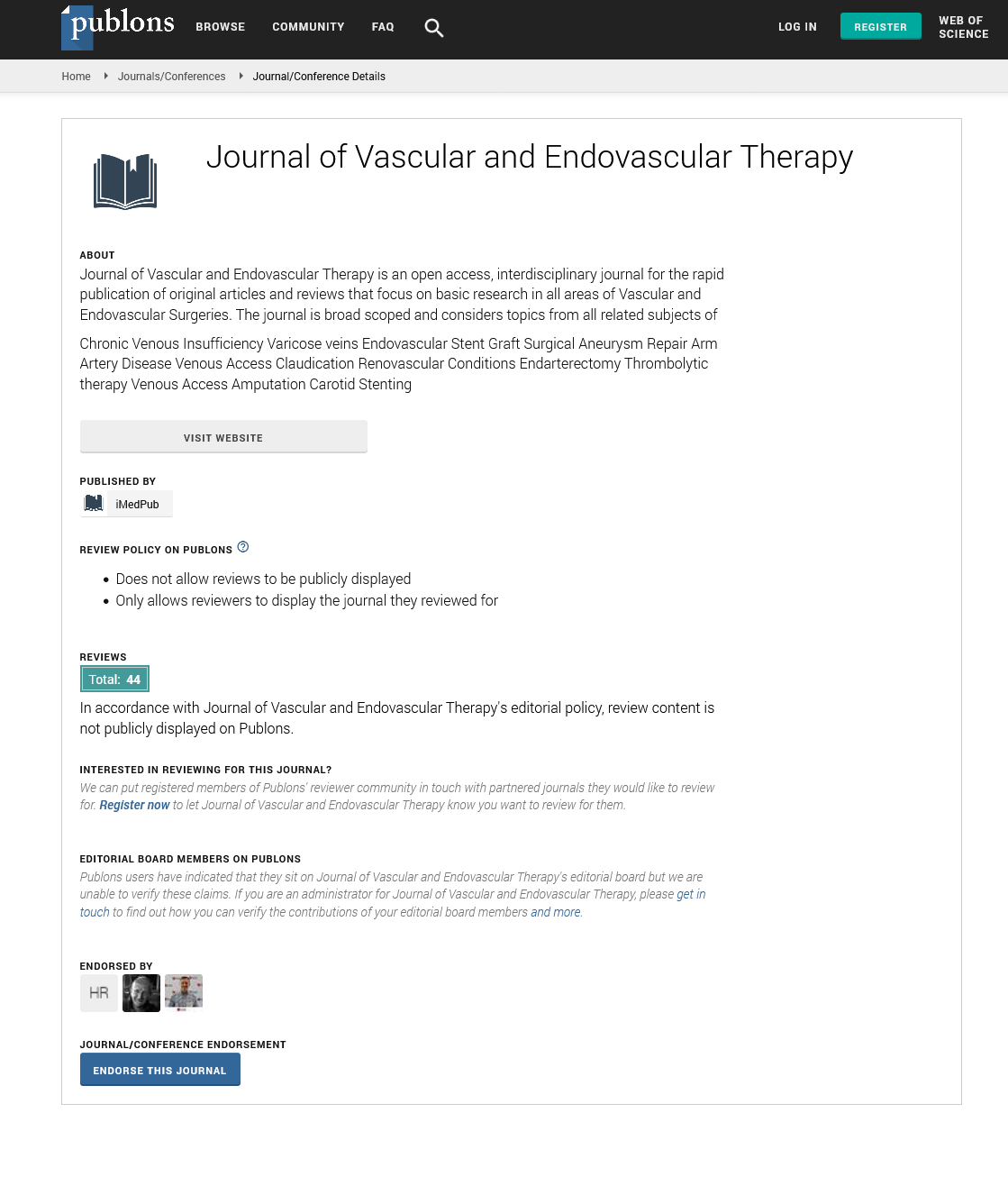ISSN : 2634-7156
Journal of Vascular and Endovascular Therapy
“Two-level” varicose veins: myth or reality?
4th Edition of World Congress & Exhibition on Vascular Surgery
March 28-29, 2019 Rome, Italy
Chernukha L M, Guch A A, Kondratyuk V A, Vlasenko E A and Bobrova A O
National Institute of Surgery and Transplantology, Ukraine
ScientificTracks Abstracts: J Vasc Endovasc Therapy
DOI: 10.21767/2573-4482-C1-005
Abstract
Aims: The main principle of treatment in patients with varicose veins (VV) of the lower limbs is the elimination of pathological venous reflux. In typical cases, reflux forms in saphenofemoral and/or safenopopliteal junction. The aim of the study was to identify the possibility of using minimally invasive interventions in patients with VV of the lower limbs to eliminate pathological venous reflux formed above the level of saphenofemoral junction.
Materials & Methods: Examination of the blood flow in the ovarian and internal iliac veins in 27 women with VV of the thigh’ posteromedial surface and gluteal region was carried out. Color duplex scanning with Valsalva test was performed for the pelvic and subcutaneous veins reflux detection. Phlebography and computed tomography were performed to exclude patients with May-Turner and nutcracker syndrome.
Results: Ultrasound signs of pelvic venous insufficiency were dilated veins of myometrium >4 mm, ovarian veins >8 mm, reverse blood flow during the Valsalva test. Varicose veins of the perineum were noted in 23 (85.18%) patients, in 18 (66.66%) VV on the thigh’ medial and posteromedial surface were observed. The blood reflux on the left ovarian vein was recorded in 19 (70.37%) cases, on the right - in 7 (25.92%). Analysis of the data led us to the idea of a “twolevel” varicose disease, in which isolated correction of the pathological venous reflux distal to the inguinal ligament inevitably led to a recurrence of VV. Endovascular methods of correction of pathological venous reflux in ovarian veins were used in 10 patients (37.03%), in 7 of them (70.0%) laser ablation with 2 ring radial fiber, in 3 (30.0%) - radiofrequency ablation.
Conclusions: Elimination of the pathological venous reflux in ovarian veins may be suggested as the method of prevention of VV recurrence caused by pelvic venous insufficiency.
Recent Publications
1. Chernukha L et al. (2016) Epidemiological aspects of comorbidity of lower limbs chronic venous disease (CVD) and haemorrhoids: the results of detect-duo. ├É┬?nt Ang├?┬?ol. 35(1-2):83.
2. L M Chernukha, O V Kashyrova, A O Guch, G G Vlaykov, O A Vlasenko, V A Kondratuk and I V Gomolyako (2017) Congenital vascular malformations: features of diagnosis and treatment (2017) The Hungerian Journal of Vascular Diseases XXIV(3):17-18.
3. Chernukha L, Kashyrova O, Vlaykov G, Guch A, Vlasenko O and Kondratyuk V (2018) The main aspects of diagnostics and treatment of diffuse arteriovenous forms of congenital vascular malformations of extremities with the presence of microfistulas. Acta Phlebologica. 19(2):49- 55..
Biography
Chernukha L M is a Leading Research Fellow of the Department of Vascular Surgery, Vascular Surgeon, Phlebologist; Vice-President of Association of Vascular Surgeons, Phlebologists, Angiologists of Ukraine; Chief Editor of “Clinical Phlebology”. She is the author of the initiative and the Head of the working group on the creation of Consensus and National Guidelines on Phlebolymphology. She is the main specialist in phlebolymphology (care patients with congenital vascular malformations, lymphedema, chronic and acute venous diseases, post-traumatic injury of magistral vessels). She is in the Editorial board of: Clinical Phlebology (Kiev), Phlebology (Moscow), Cardiac Surgery and Interventional Cardiology (Kiev), Angiology and Vascular Surgery (Moscow) and, Surgery New (Vitebsk).
E-mail: vasc.phlebo@gmail.com
Google Scholar citation report
Citations : 177
Journal of Vascular and Endovascular Therapy received 177 citations as per Google Scholar report
Journal of Vascular and Endovascular Therapy peer review process verified at publons
Abstracted/Indexed in
- Google Scholar
- Open J Gate
- Publons
- Geneva Foundation for Medical Education and Research
- Secret Search Engine Labs
Open Access Journals
- Aquaculture & Veterinary Science
- Chemistry & Chemical Sciences
- Clinical Sciences
- Engineering
- General Science
- Genetics & Molecular Biology
- Health Care & Nursing
- Immunology & Microbiology
- Materials Science
- Mathematics & Physics
- Medical Sciences
- Neurology & Psychiatry
- Oncology & Cancer Science
- Pharmaceutical Sciences
